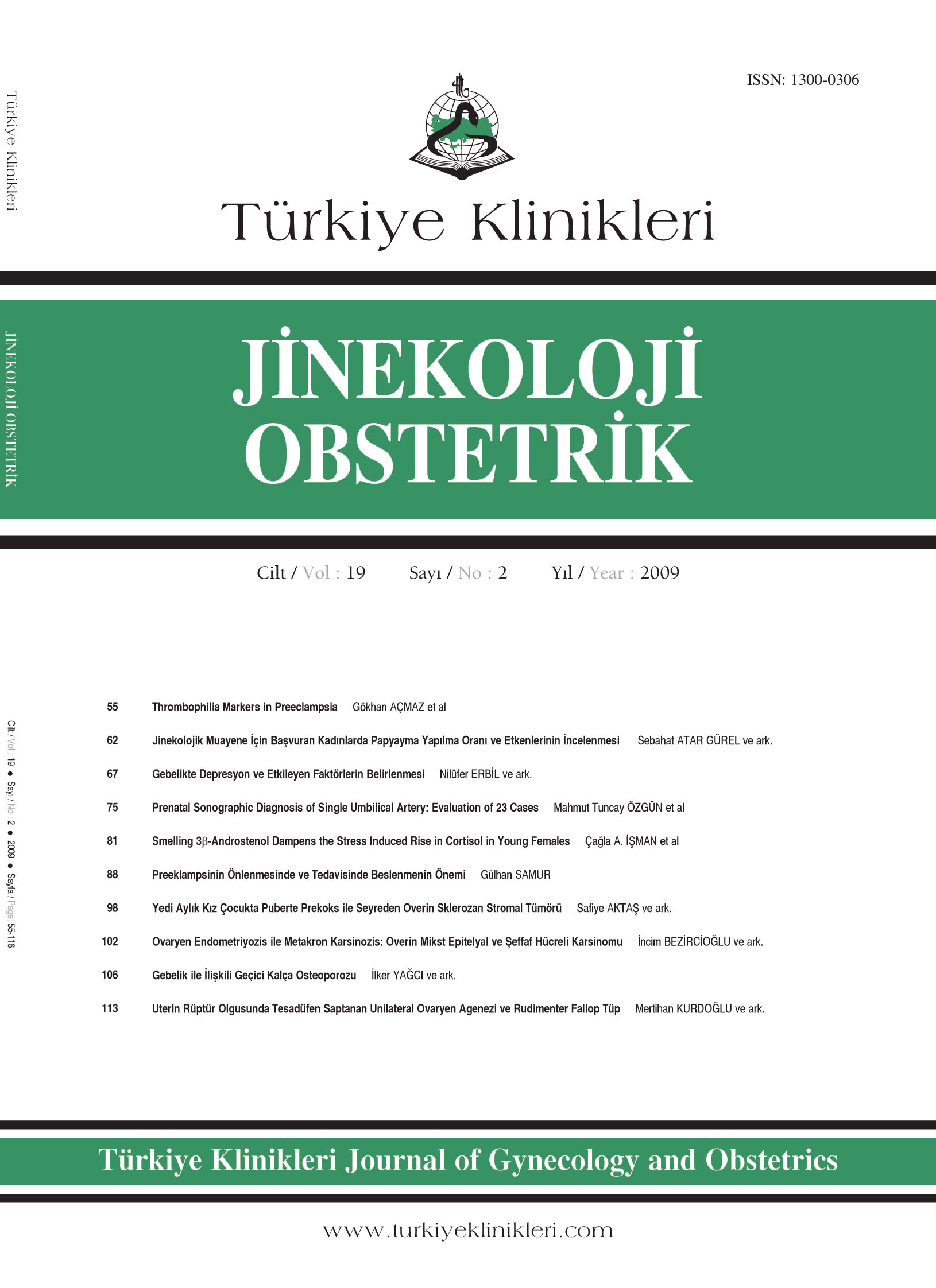Open Access
Peer Reviewed
ORIGINAL RESEARCH
1691 Viewed802 Downloaded
Prenatal Sonographic Diagnosis of Single Umbilical Artery: Evaluation of 23 Cases
Prenatal Sonografide Tek Umbilikal Arter Tanısı: 23 Olgunun Değerlendirilmesi
Turkiye Klinikleri J Gynecol Obst. 2009;19(2):75-80
Article Language: EN
Copyright Ⓒ 2020 by Türkiye Klinikleri. This is an open access article under the CC BY-NC-ND license (http://creativecommons.org/licenses/by-nc-nd/4.0/)
ABSTRACT
Objective: Single umbilical artery (SUA) is associated with congenital anomalies, abnormal karyotypes and adverse perinatal outcome including intrauterine growth retardation (IUGR), low birth weight and prematurity. The aim of this study was to present perinatal results of cases with SUA. Material and Methods: This is a retrospective analysis of prenatally diagnosed 23 cases with SUA out of 3558 pregnancies between January 2004 and December 2007. Results: The gestational age at diagnosis varied between 14 and 34 weeks. The mean maternal age was 27.4 ± 4.7 (22-40) years. The median parity was 0 (range 0-4). Six of the 23 fetuses had additional congenital anomalies including bilateral renal agenesis (n= 1), unilateral renal agenesis (n= 2) or cardiac malformations (n= 3). IUGR was detected in one fetus. Eight fetuses had soft markers for chromosomal anomalies and SUA was isolated in 8 (35%) cases. The karyotype of all 11 fetuses with additional anomalies or soft markers was normal. One case was terminated at 18 weeks due to bilateral renal agenesis. Preterm delivery complicated five pregnancies. After birth, 6 fetuses were diagnosed to be small for gestational age. Three babies died after birth. All of these fetuses had a congenital anomaly along with SUA. Conclusion: A targeted ultrasound examination for detection of additional anomalies and soft markers should be performed in cases with SUA. Close surveillance is necessary for monitoring fetal growth and fetal well-being in cases with SUA.
Objective: Single umbilical artery (SUA) is associated with congenital anomalies, abnormal karyotypes and adverse perinatal outcome including intrauterine growth retardation (IUGR), low birth weight and prematurity. The aim of this study was to present perinatal results of cases with SUA. Material and Methods: This is a retrospective analysis of prenatally diagnosed 23 cases with SUA out of 3558 pregnancies between January 2004 and December 2007. Results: The gestational age at diagnosis varied between 14 and 34 weeks. The mean maternal age was 27.4 ± 4.7 (22-40) years. The median parity was 0 (range 0-4). Six of the 23 fetuses had additional congenital anomalies including bilateral renal agenesis (n= 1), unilateral renal agenesis (n= 2) or cardiac malformations (n= 3). IUGR was detected in one fetus. Eight fetuses had soft markers for chromosomal anomalies and SUA was isolated in 8 (35%) cases. The karyotype of all 11 fetuses with additional anomalies or soft markers was normal. One case was terminated at 18 weeks due to bilateral renal agenesis. Preterm delivery complicated five pregnancies. After birth, 6 fetuses were diagnosed to be small for gestational age. Three babies died after birth. All of these fetuses had a congenital anomaly along with SUA. Conclusion: A targeted ultrasound examination for detection of additional anomalies and soft markers should be performed in cases with SUA. Close surveillance is necessary for monitoring fetal growth and fetal well-being in cases with SUA.
ÖZET
Amaç: Tek umbilikal arter (TUA) konjenital anomaliler, kromozom anomalileri ve düşük doğum ağırlığı, prematürite ile intrauterin gelişme geriliği gibi olumsuz perinatal akıbet ile birlikte olabilir. Bu çalışmanın amacı TUA saptanan olguların perinatal sonuçlarını sunmaktır. Gereç ve Yöntemler: Bu retrospektif çalışmaya Ocak 2004 ile Aralık 2007 tarihleri arasında arasında değerlendirilen 3558 gebelikten TUA saptanan 23 olgu dahil edildi. Bulgular: Fetuslara 14 ile 34 gebelik haftaları arasında tanı konuldu. Ortalama maternal yaş 27.4 ± 4.7 (22-40) yıl, median parite 0 (0-4 arasında) olarak bulundu. Altı fetusta ek anomali saptandı ve bunlar, bilateral renal agenezi (n= 1), tek taraflı renal agenezi (n= 2), ve kardiyak anomali (n= 3) şeklinde idi. Bir fetusta ise intrauterin gelişme geriliği saptandı. Sekiz fetusta kromozom anomalisi ile ilişkili "soft marker" izlenirken, 8 (%35) olguda ise izole TUA saptandı. Ek anomali veya "soft marker" saptanan 11 olguda karyotip analizi yapıldı ve bunların hepsinde normal karyotip saptandı. Bilateral renal agenezi saptanan bir olguda gebelik 18. haftada sonlandırıldı. Beş olguda erken doğum oldu, 6 olguda ise doğum sonrası bebeklerin gebelik haftasına göre düşük doğum ağırlıklı oldukları saptandı. Doğum sonrası ek anomalileri olan 3 bebek kaybedildi. Sonuç: TUA saptanan olgularda ek anomaliler ve "soft marker" olup olmadığının araştırılması için detaylı ultrason incelemesi yapılmaldır. Bu hastalarda fetal gelişimin ve fetal iyilik halinin takibi gereklidir.
Amaç: Tek umbilikal arter (TUA) konjenital anomaliler, kromozom anomalileri ve düşük doğum ağırlığı, prematürite ile intrauterin gelişme geriliği gibi olumsuz perinatal akıbet ile birlikte olabilir. Bu çalışmanın amacı TUA saptanan olguların perinatal sonuçlarını sunmaktır. Gereç ve Yöntemler: Bu retrospektif çalışmaya Ocak 2004 ile Aralık 2007 tarihleri arasında arasında değerlendirilen 3558 gebelikten TUA saptanan 23 olgu dahil edildi. Bulgular: Fetuslara 14 ile 34 gebelik haftaları arasında tanı konuldu. Ortalama maternal yaş 27.4 ± 4.7 (22-40) yıl, median parite 0 (0-4 arasında) olarak bulundu. Altı fetusta ek anomali saptandı ve bunlar, bilateral renal agenezi (n= 1), tek taraflı renal agenezi (n= 2), ve kardiyak anomali (n= 3) şeklinde idi. Bir fetusta ise intrauterin gelişme geriliği saptandı. Sekiz fetusta kromozom anomalisi ile ilişkili "soft marker" izlenirken, 8 (%35) olguda ise izole TUA saptandı. Ek anomali veya "soft marker" saptanan 11 olguda karyotip analizi yapıldı ve bunların hepsinde normal karyotip saptandı. Bilateral renal agenezi saptanan bir olguda gebelik 18. haftada sonlandırıldı. Beş olguda erken doğum oldu, 6 olguda ise doğum sonrası bebeklerin gebelik haftasına göre düşük doğum ağırlıklı oldukları saptandı. Doğum sonrası ek anomalileri olan 3 bebek kaybedildi. Sonuç: TUA saptanan olgularda ek anomaliler ve "soft marker" olup olmadığının araştırılması için detaylı ultrason incelemesi yapılmaldır. Bu hastalarda fetal gelişimin ve fetal iyilik halinin takibi gereklidir.
MENU
POPULAR ARTICLES
MOST DOWNLOADED ARTICLES





This journal is licensed under a Creative Commons Attribution-NonCommercial-NoDerivatives 4.0 International License.











